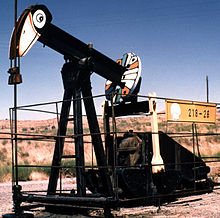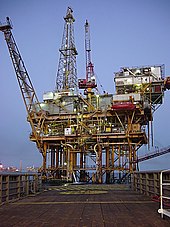During World War II, Germany received much of its oil from Romania. From 2.8 million barrels (450×103 m3) in 1938, Romania’s exports to Germany increased to 13 million barrels (2.1×106 m3) by 1941, a level that was essentially maintained through 1942 and 1943, before dropping by half, due to Allied bombing and mining of the Danube. Although these exports were almost half of Romania’s total production, they were considerably less than the Germans had expected. Even with the addition of the Romanian deliveries, oil imports over land after 1939 could not make up for the loss of overseas shipments. To become less dependent on outside sources, the Germans undertook a sizable expansion program of their own meager domestic oil pumping. After 1938, they had access to the Austrian oil fields, and the expansion of Nazi crude oil output was chiefly concentrated there. Primarily as a result of this expansion, the Reich's domestic output of crude oil increased from approximately 3.8 million barrels (600×103 m3) in 1938 to almost 12 million barrels (1.9×106 m3) in 1944, but even that output was not sufficient to meet all the needs of the Nazi military.
Instead, Germany had developed a synthetic fuel capacity that was intended to replace imported or captured oil. Fuel was generated from coal, using either the Bergius process or the Fischer-Tropsch process. Between 1938 and 1943, synthetic fuel output underwent a respectable growth from 10,000,000 barrels (1,600,000 m3) to 36,000,000 barrels (5,700,000 m3). The percentage of synthetic fuels compared with the yield from all sources grew from 22% to more than 50% by 1943. The total oil supplies available from all sources for the same period rose from 45 million barrels (7.2×106 m3) in 1938 to 71 million barrels (11.3×106 m3) in 1943.
By the early 1930s, automobile gasoline had an octane rating of 40 and aviation gasoline a rating of 75-80. Aviation gasoline with such high octane numbers could only be refined through a process of distillation of high-grade petroleum. Germany’s domestic oil was not of this quality. Only the additive tetra-ethyl lead could raise the octane to a maximum of 87. The license for the production of this additive was acquired in 1935 from the American holder of the patents, but without high-grade Romanian oil even this additive was not very effective. 100 octane fuel, designated either 'C-2' (natural) or 'C-3' (synthethic) was introduced in late 1939 with the Daimler-Benz DB 601N engine, used in certain of the Luftwaffe's Bf 109E and Bf 109F single-engined fighters, Bf 110C twin-engined fighters, and several bomber types. Some later combat types, most notably the BMW 801D-powered Fw 190A, F and G series, and later war Bf 109G and K models, used C-3 as well. The nominally 87 octane aviation fuel designated 'B-4' was produced in parallel during the war.
In the United States the oil was not "as good", and the oil industry had to invest heavily in various expensive boosting systems. This turned out to have benefits: the US industry started delivering fuels of increasing octane ratings by adding more of the boosting agents, and the infrastructure was in place for a post-war octane-agents additive industry. Good crude oil was no longer a factor during wartime, and by war's end American aviation fuel was commonly 130 octane, and 150 octane was available in limited quantities for fighters from mid-1944. This high octane could easily be used in existing engines to deliver much more power by increasing the pressure delivered by the superchargers.
In late 1942, the Germans increased the octane rating of their high-grade 'C-3' aviation fuel to 150 octane. The relative volumes of production of the two grades B-4 and C-3 cannot be accurately given, but in the last war years perhaps two-thirds of the total was C-3. Every effort was being made toward the end of the war to increase isoparaffin production; more isoparaffin meant more C-3 available for fighter plane use.
A common misconception exists concerning wartime fuel octane numbers. There are two octane numbers for each fuel, one for lean mix and one for rich mix, rich being greater. The misunderstanding that German fuels had a lower octane number (and thus a poorer quality) arose because the Germans quoted the lean mix octane number for their fuels while the Allies quoted the rich mix number. Standard German high-grade 'C-3' aviation fuel used in the later part of the war had lean/rich octane numbers of 100/130. The Germans listed this as a 100 octane fuel, the Allies as 130 octane.
After the war, the US Navy sent a technical mission to Germany to interview German petrochemists and examine German fuel quality. Its report entitled “Technical Report 145-45 Manufacture of Aviation Gasoline in Germany” chemically analyzed the different fuels, and concluded that “Toward the end of the war the quality of fuel being used by the German fighter planes was quite similar to that being used by the Allies.”







